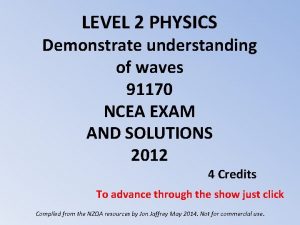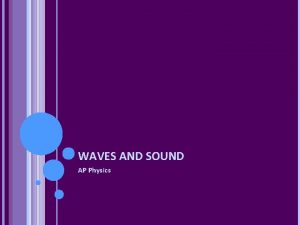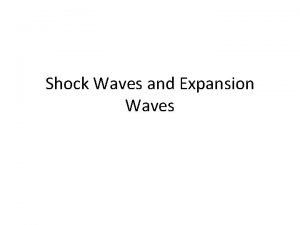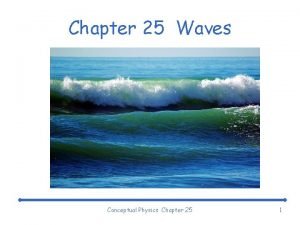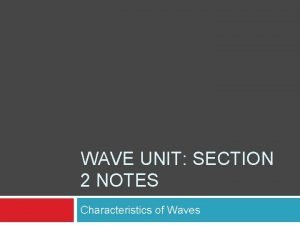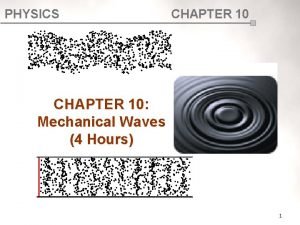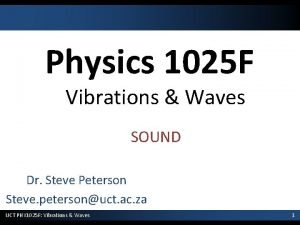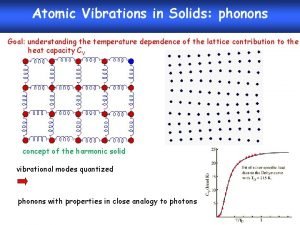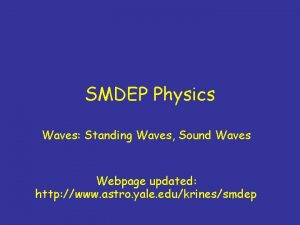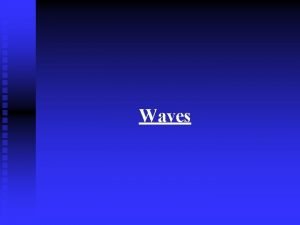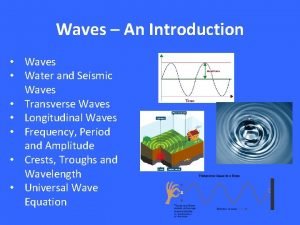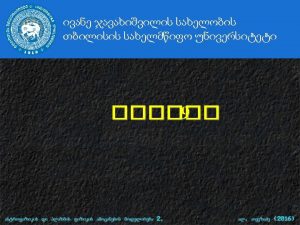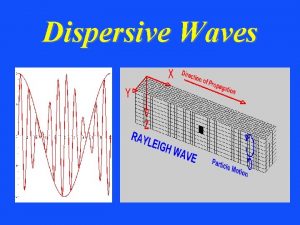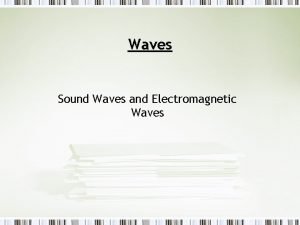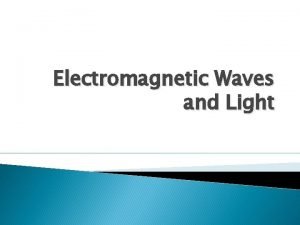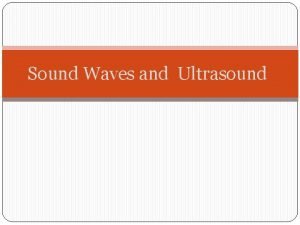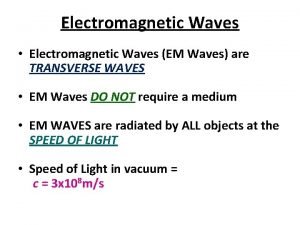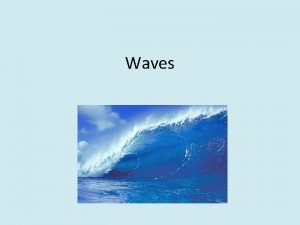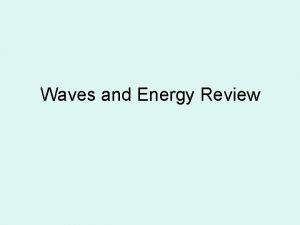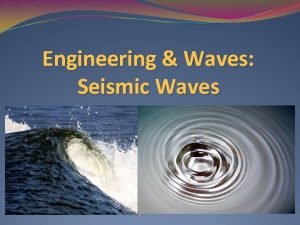LEVEL 2 PHYSICS Demonstrate understanding of waves 91170

























- Slides: 25

LEVEL 2 PHYSICS Demonstrate understanding of waves 91170 NCEA EXAM AND SOLUTIONS 2012 4 Credits To advance through the show just click Compiled from the NZQA resources by Jon Jaffrey May 2014. Not for commercial use.

This is the sort of evidence statement that grades each of the questions on the paper: Not Achieved N 1 N 2 ONE TWO correct Achieve points 1 a 2 a Achievement A 3 A 4 THREE correct Achieve points FOUR correct Achieve points 3 a 4 a Achievement with Merit M 5 M 6 ONE TWO Merit point Merit and THREE points and Achieve TWO Achieve 1 m + 3 a 2 m + 2 a Achievement with Excellence E 7 E 8 ONE Excellence point plus TWO Merit point 1 e + 2 m TWO Excellence point plus ONE Merit You score zero (N 0) if you make no relevant points in the question. For each question you get graded from 0 to 8 marks. These marks are then added to give an overall score for the paper. The last slide has the judgement statement which shows how this final score will give your grade 2 e + 1 m

You may find the following formulae useful OR n 1 sinθ 1 = n 2 sinθ 2 si so = f 2 OR You are advised to spend 60 minutes answering the questions in this booklet.

QUESTION ONE: CURVED MIRRORS AND LENSES Sarah observed that it is possible to get a virtual image of an object using either a concave or a convex mirror. (a) On each of the diagrams below, use a ruler to draw the path of two rays of light from an object (draw this as an arrow) to produce a virtual image for both a concave as well as a convex mirror. The vertical line represents the curved mirror. (i) Concave mirror F (ii) Convex mirror C F (b) Describe two characteristics of virtual images in mirrors. C

(c) Sarah places a candle at a distance of 4. 5 cm in front of the convex mirror. She uses a candle that is 2. 0 cm high as the object. The focal length of the convex mirror is 6. 0 cm. Calculate the height of the image formed by the convex mirror. (d) Jack is given two convex lenses. The lenses are identical in shape, but have different refractive indices. Jack places the two lenses the same distance from a candle and sees a virtual image of the candle in each lens. Explain why the images formed by the two lenses are different in size. Draw diagrams to help your explanation. The arrow represents the candle. Lens with lower refractive index Lens with higher refractive index Solutions to QUESTION ONE are on the next slide …………. .

(a) On each of the diagrams below, use a ruler to draw the path of two rays of light from an object (draw this as an arrow) to produce a virtual image for both a concave as well as a convex mirror. The vertical line represents the curved mirror. (i) Concave mirror (ii) Convex mirror Virtual image “ACHIEVE” for : Object positioned between mirror and F for concave mirror. F C C “MERIT” for : Rays drawn correctly to obtain enlarged virtual image for concave mirror. F Virtual image “ACHIEVE” for : Rays drawn correctly to obtain diminished upright virtual image. (b) Describe two characteristics of virtual images in mirrors. v The rays only appear to intersect to form the image. OR “ACHIEVE” for : “MERIT” for : v Image is always upright. Any ONE of Any TWO of OR these points v Image cannot be formed on a screen. OR v Image is always behind the mirror. I think “laterally inverted” should be accepted too!

(c) Sarah places a candle at a distance of 4. 5 cm in front of the convex mirror. She uses a candle that is 2. 0 cm high as the object. The focal length of the convex mirror is 6. 0 cm. Calculate the height of the image formed by the convex mirror. Answer : This is an excellence question but you can get Achieve or Merit for a good attempt. Virtual focus so negative f “ACHIEVE” for : Correct substitution in equation OR uses so = 10. 5 cm OR Using f = +6 giving hi = 8 cm “MERIT” for : di = -2. 57 cm OR Correct substitution in Newton’s formula, but incorrect answer di = -2. 57 cm “EXCELLENCE” for correct working and answer hi = -1. 14 cm Virtual image so negative h hi = -1. 14 cm

(d) Jack is given two convex lenses. The lenses are identical in shape, but have different refractive indices. Jack places the two lenses the same distance from a candle and sees a virtual image of the candle in each lens. Explain why the images formed by the two lenses are different in size. Draw diagrams to help your explanation. The arrow represents the candle. Answer : To form a virtual image the object must be between the lens and the focal plane. The undeviated ray through the pole is the same for both lenses. The longer the focal length of the lens the closer to the object the image will form. The glass with lower refractive index will not refract the light rays as much so the lens will have a longer focal length. v This will give less magnification. v The closer the lens is to being flat glass, the closer the image will be to being identical in size to the object. v v Lens with lower refractive index Lens with higher refractive index Marking details on the next slide ……. .

“ACHIEVE” for : Diagram for lens with higher refractive index shows a shorter focal length. OR WRITTEN A greater refractive index means rays will bend more. OR A greater refractive index will mean a shorter focal length. “MERIT” for : Diagram for lens with higher refractive index shows a shorter focal length and hence the image is formed further away. OR A greater refractive index will mean a shorter focal length , resulting in light rays crossing the principal axis closer to the lens. “EXCELLENCE” for Since rays through F bend more, they will appear to meet further away from the lens and hence a larger image will be formed. OR evidence from diagram OR Since magnification is the size of the image will be greater, when using a convex lens with a higher refractive index.

NZQA JUDGEMENT STATEMENT FOR QUESTION ONE: Not Achieved N 1 N 2 ONE TWO correct Achieve points 1 a 2 a Achievement with Merit Achievement with Excellence A 3 A 4 M 5 M 6 E 7 E 8 THREE correct Achieve points FOUR correct Achieve points TWO Merit point and ONE Achieve THREE Merit points TWO Excellence point plus ONE Merit 3 a OR 1 a + 1 m 4 a OR 2 m 2 m + 1 a OR 1 m + 1 e 3 m ONE Excellence point plus TWO Merit point 1 e + 2 m OR 2 e You can get “ACHIEVE” in all parts of the question for 8 or 9 ideas. You can get “MERIT” from three parts for 5 or 6 ideas 2 e + 1 m “EXCELLENCE” can only be gained from detailed and correct answers in (c) & (d)

QUESTION TWO: REFRACTION One way to determine the critical angle of Perspex (acrylic glass) is to use a semi-circular Perspex block, through which a ray of light is passed an angle measured. (a) Complete the diagram below to show the path of a ray of light when used to determine the critical angle of Perspex. On your diagram mark the critical angle. The normal has been drawn for you. Perspex (b) State two conditions necessary for total internal reflection to occur. (c) In the above experiment, the critical angle of Perspex was found to be 42°. Determine the refractive index of Perspex. The refractive index of air is 1. 0.

(d) A ray of light is shone through a rectangular block of glass at an angle of 56° to the surface of the glass, as shown in the diagram. The glass block is 10. 0 cm long and 8. 0 cm wide. Calculate the distance the ray of light travels through the glass before emerging into the air. Refractive index of air = 1. 0 Refractive index of glass = 1. 5 56° 8. 0 cm 10. 0 cm Solutions to QUESTION TWO are on the next slide …………. .

(a) Complete the diagram below to show the path of a ray of light when used to determine the critical angle of Perspex. On your diagram mark the critical angle. The normal has been drawn for you. Answer : “ACHIEVE” for : Correct angle marked for critical angle OR Perspex Outgoing ray at 900 “MERIT” for : Correct angle marked for critical angle. AND Refracted ray at 90. OR Total Internal Reflection. (b) State two conditions necessary for total internal reflection to occur. v The light must be travelling form a higher refractive index medium (optically denser) to a lower refractive index medium. v The angle of incidence must be greater than the critical angle. “ACHIEVE” for : ONE point made. “MERIT” for : BOTH points made.

(c) In the above experiment, the critical angle of Perspex was found to be 42°. Determine the refractive index of Perspex. The refractive index of air is 1. 0. Answer : You will need to use the equation: n 1 sinθ 1 = n 2 sinθ 2 with θ 2 set to 900. This makes sin θ 2 = 1 : n 1 sin 42 = 1 x 1 n 1 0. 6913 = 1 n 1 = 1. 4945 = 1. 5 “ACHIEVE” for : n 1 sinθ 1 = n 2 sinθ 2 n 1 sin 42 = 1 sin 90 “MERIT” for : Correct working and answer.

Angle of incidence θ 1 (d) Calculate the distance the ray of light travels through the glass before emerging into the air. Refractive index of air = 1. 0 Refractive index of glass = 1. 5 56° Answer : Angle of refraction θ 2 You will need to find the length of this line: You will need to find the angle of refraction inside the glass block. Then a little trigonometry will solve for you. 8. 0 cm You will need to use the equation: n 1 sinθ 1 = n 2 sinθ 2 1 sin 34 = 1. 5 sinθ 2 0. 55919 = 1. 5 sinθ 2 0. 3728 = sinθ 2 = 21. 90 “ACHIEVE” for : θ 1 = (90 – 56) = 340 OR Using 56° = 9. 6 cm So 0. 9279 = 8. 0 / path length Distance in block = 8. 622 cm = 8. 6 cm 10. 0 cm “MERIT” for : Correct working to θ 2 = 21. 90 “EXCELLENCE” for correct working and answer

NZQA JUDGEMENT STATEMENT FOR QUESTION TWO: Not Achieved N 1 N 2 ONE TWO correct Achieve points 1 a 2 a Achievement A 3 A 4 THREE correct Achieve points FOUR correct Achieve points 3 a OR 1 a + 1 m 4 a OR 2 m You can get “ACHIEVE” in all parts of the question for 5 or 6 ideas. Achievement with Merit M 5 M 6 TWO Merit point Merit and ONE points and Achieve TWO Achieve 2 m + 1 a 2 m + 2 a You can get “MERIT” for 4 ideas Achievement with Excellence E 7 E 8 ONE Excellence point plus TWO Merit point ONE Excellence point plus THREE Merit 1 e + 2 m 1 e + 3 m “EXCELLENCE” can only be gained from detailed and correct answers in (d)

QUESTION THREE: WAVES The following diagram shows parallel wave fronts approaching shallow water. Waves travel slower in shallow water. (a) Complete the diagram with labelled arrows showing the following: v direction of travel of incident wavefronts v direction of travel of reflected wavefronts v direction of travel of refracted (transmitted) wavefronts. deep water shallow water (b) Draw the refracted wavefronts for the same situation as given above, in the diagram here:

A boat is anchored in a harbour behind a sea-wall separating it from the open sea. There is a gap in between two sea-walls as shown below. A sea-wall is a structure that is built to protect a harbour from waves. Waves from the sea go towards the gap between the two sea-walls. (c) On the diagram below, show what happens to the waves once they go through the gap between the two sea-walls. Include direction of the waves in your drawing. Describe and explain the effect the waves will have on the boat. incoming waves from the sea wall boat

The diagram below shows parallel wavefronts approaching TWO gaps. The wavelength of the waves is 4. 0 m. A boat is anchored 3. 0 m from gap A and 5. 0 m from gap B. (d) Describe and explain the effect of the waves on the motion of the boat, giving reasons. In your answer, state what happens to the wavefronts as they go through the two gaps. A 3 m B 5 m Solutions to QUESTION THREE are on the next slide …………. .

Waves travel slower in shallow water. (a) Complete the diagram with labelled arrows showing the following: direction of travel of incident wavefronts & direction of travel of reflected wavefronts & direction of travel of refracted (transmitted) wavefronts. (a) “ACHIEVE” for: Shows 2 correct (b) Draw the refracted wavefronts for the same situation as given above. directions deep water (a) “MERIT” for : Shows THREE correct rays (b) “ACHIEVE” for : Diagram showing refracted wavefronts closer OR Refracted wavefronts travelling in approximately the correct direction shallow water The scheme says: Holistic: mark (a) and (b) together (b) “MERIT” for : Diagram showing refracted wavefronts closer. AND Refracted wavefronts travelling in approximately the correct direction.

(c) On the diagram below, show what happens to the waves once they go through the gap between the two sea-walls. Include direction of the waves in your drawing. Describe and explain the effect the waves will have on the boat. incoming waves from the sea wall boat The wavelength is about the same size as the gap. The waves will diffract on the other side of the gap. The gap will act like a point source and produce semi-circular waves. There will be little or no movement of the boat since most of the energy will be directed away from it. Marking details on the next slide ……. .

“ACHIEVE” for : Diagram shows circular waves. OR alternatively: Diagram shows plane waves = to gap. “MERIT” for : Diagram shows waves. PLUS TWO of three: v Arrow(s) OR The waves would diffract around the gap in the barrier. OR The boat would move up and down as the waves pass under it. PLUS No / little diffraction. “EXCELLENCE” for Diagram shows waves including direction of waves. AND The waves would diffract around the gap in the barrier. AND The boat would then move up and down as the waves pass under it. PLUS No movement.

(d) Describe and explain the effect of the waves on the motion of the boat, giving reasons. In your answer, state what happens to the wavefronts as they go through the two gaps. The waves will diffract through the gaps. Each will produce semi-circular wave patterns which will overlap and interfere. A 3 m λ = 4. 0 m. B λ = 4. 0 m so the path difference is ½ λ. “ACHIEVE” for : Waves from B travel ½ λ further so a peak will meet a Words OR diagram. trough. The waves will cancel (destructively interfere) Circular wavefronts are produced as as they reach the boat. the waves go through each gap. The boat will remain still. OR Boat will remain calm due to destructive interference. “MERIT” for : “EXCELLENCE” for Waves from gap B will have Answer linked to Path difference. to travel an extra 2. 0 m to reach the boat. OR Phase difference. AND This means the path difference is half a wavelength. So the waves will interfere destructively. AND Hence the boat will remain calm. 5 m

NZQA JUDGEMENT STATEMENT FOR QUESTION THREE: Not Achieved N 1 N 2 ONE TWO correct Achieve points 1 a 2 a Achievement A 3 A 4 THREE correct Achieve points FOUR correct Achieve points 3 a OR 1 a + 2 m 4 a OR 2 m You can get “ACHIEVE” in all parts of the question for 6 or 7 ideas. Achievement with Merit M 5 M 6 TWO Merit point Merit and ONE points and Achieve TWO Achieve 2 m + 1 a 2 m + 2 a You can get “MERIT” for 5 or 6 ideas Achievement with Excellence E 7 E 8 ONE Excellence point plus TWO Merit point 1 e + 2 m OR 2 e TWO Excellence point plus ONE Merit 2 e + 1 m “EXCELLENCE” can only be gained from detailed and correct answers in (c) & (d)

OVERALL JUDGEMENT STATEMENT: Your final grade comes from adding up your marks from all four questions Score range Not Achieved Achievement 0 – 6 7 – 14 Achievement with Merit with Excellence 15 – 19 20 – 24 One A 3 plus two N 2 would just get “ACHIEVE” ( = 7 ) One M 6 + one M 5 + one A 4 would just get “MERIT” ( = 15 ) Two E 7 + one M 6 would just get “EXCELLENCE” ( =20 ) Compiled from NZQA resources by Jon Jaffrey May 2014. Not for commercial use.
 Waves level 2
Waves level 2 Demonstrate knowledge and understanding
Demonstrate knowledge and understanding Difference between mechanical and electromagnetic waves
Difference between mechanical and electromagnetic waves Light is an electromagnetic wave true or false
Light is an electromagnetic wave true or false Mechanical wave
Mechanical wave Similarities of mechanical waves and electromagnetic waves
Similarities of mechanical waves and electromagnetic waves What type of waves are sound waves? *
What type of waves are sound waves? * Is echolocation transverse or longitudinal
Is echolocation transverse or longitudinal Carbon dioxide temperature
Carbon dioxide temperature Difference between matter waves and electromagnetic waves
Difference between matter waves and electromagnetic waves Mechanical waves vs electromagnetic waves
Mechanical waves vs electromagnetic waves Mechanical and electromagnetic waves similarities
Mechanical and electromagnetic waves similarities Surface waves and body waves
Surface waves and body waves Seismic waves are mechanical waves
Seismic waves are mechanical waves Compare and contrast p waves and s waves using venn diagram
Compare and contrast p waves and s waves using venn diagram Mechanical waves and electromagnetic waves venn diagram
Mechanical waves and electromagnetic waves venn diagram Differences between constructive and destructive waves
Differences between constructive and destructive waves Ap physics waves
Ap physics waves Prandtl meyer expansion
Prandtl meyer expansion Physics 101 lecture notes pdf
Physics 101 lecture notes pdf Bow wave aircraft
Bow wave aircraft Wave speed examples
Wave speed examples Displacement equation
Displacement equation Waves physics
Waves physics Understanding solid state physics
Understanding solid state physics Why does it happen
Why does it happen
